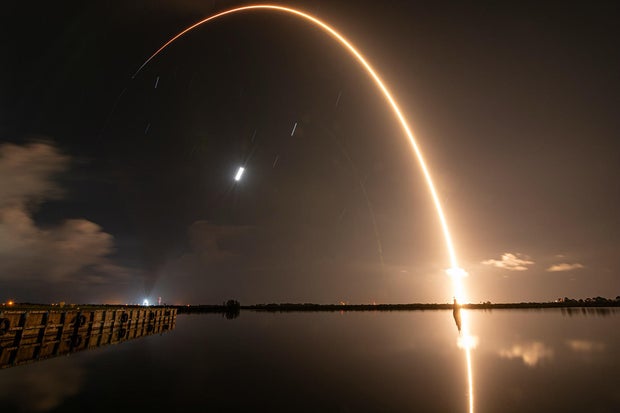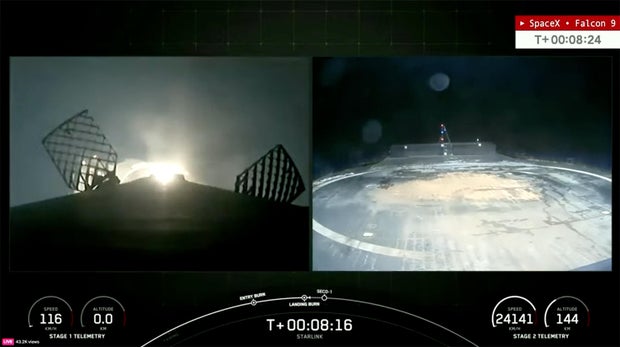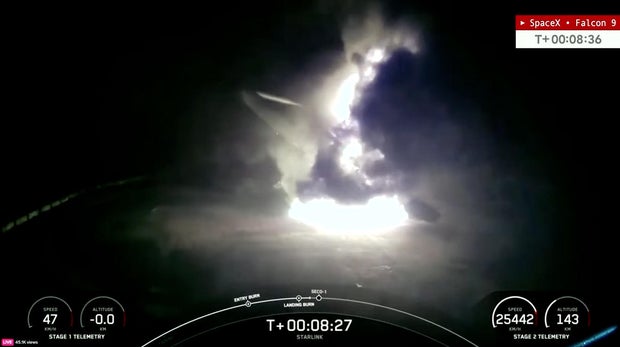after Polaris Dawn crewed launch vehicle lifts off late TuesdaySpaceX has changed course and moved forward with plans to launch back-to-back Starlink internet satellites early Wednesday morning, one from Florida and the other from California.
But the second flight was aborted after the first stage used for the Florida launch fell into the Atlantic Ocean and disintegrated while attempting to land on a SpaceX drone ship hundreds of miles northeast of Cape Canaveral. The landing mishap ended a streak of 267 successful booster recoveries dating back to February 2021.
Meanwhile, the second stage of the Falcon 9 rocket successfully carried 21 Starlink satellites into their planned orbit.
Michael Caine/Space Flight Now
The first stage’s descent appeared normal until the moment of landing, when flames appeared larger than usual around the base of the rocket as it approached the surface of the rocket. One of the landing supports collapsed immediately after the rocket touched down, and the booster rocket, obscured by flames and smoke, flipped over the side of the landing craft into the Atlantic Ocean.
“After a successful ascent, the Falcon 9 first stage flipped after landing on the A Shortfall of Gravitas drone ship. Teams are currently evaluating the rocket’s flight data and condition,” SpaceX said on its X social media site.
This was the 23rd first stage of the B1062 rocket, which has made it to its final launch and landing, setting a new reusability record. SpaceX is working to certify its Falcon 9 first stages for up to 40 flights per stage.
SpaceX
SpaceX
SpaceX
Shortly after deploying the Starlink satellites launched from Florida, SpaxeX canceled the California launch, which was scheduled for 5:58 a.m. EST, to give engineers more time to review telemetry and video footage, looking for any signs of a problem that could affect other rockets.
“We have paused our second @Starlink launch tonight to give the team time to review the booster landing data from the previous launch,” SpaceX said on its website. “A new target launch date will be shared as soon as it is available.”
Here are updated stats for the Falcon 9 rocket as of its launch in Florida this morning:
Total Falcon 9 launches to date: 367
Total Falcon Heavy launches to date: 10
Total Super Heavy/Starship launches to date: 4
Falcon 9/Heavy launches this year: 83 (82 F9s, 1 FH)
Falcon 9 in flight/serious failures: 2 (06/28/15, 07/11/24)
Successful Falcon 9/Heavy launches in a row: 13
Most successful consecutive flights: 344 (between 6/28/15 and 7/11/24)
Starlink launches to date: 190 (181 dedicated flights, 9 mixed payloads)
Starlink launches this year: 58
Starlink satellites launched so far: 6,920
Starlink satellites with direct cell capability: 136
Starlinks network is assumed to be working fine before the recent launch: 6269*
SpaceX launches payloads into orbit this year: 1,548
Fleet Leader Phase 1: B1062, 23 flights (booster lost on landing)
Number of landings in California so far: 20
Number of landings in Florida so far: 54
Drone landings to date: 267 (excluding today’s flight)
Total number of successful booster rocket landings: 341
Consecutive successful landings of booster aircraft: 267 (before today’s flight)
*Source: https://planet4589.org/space/con/star/stats.html

“Beer aficionado. Gamer. Alcohol fanatic. Evil food trailblazer. Avid bacon maven.”




